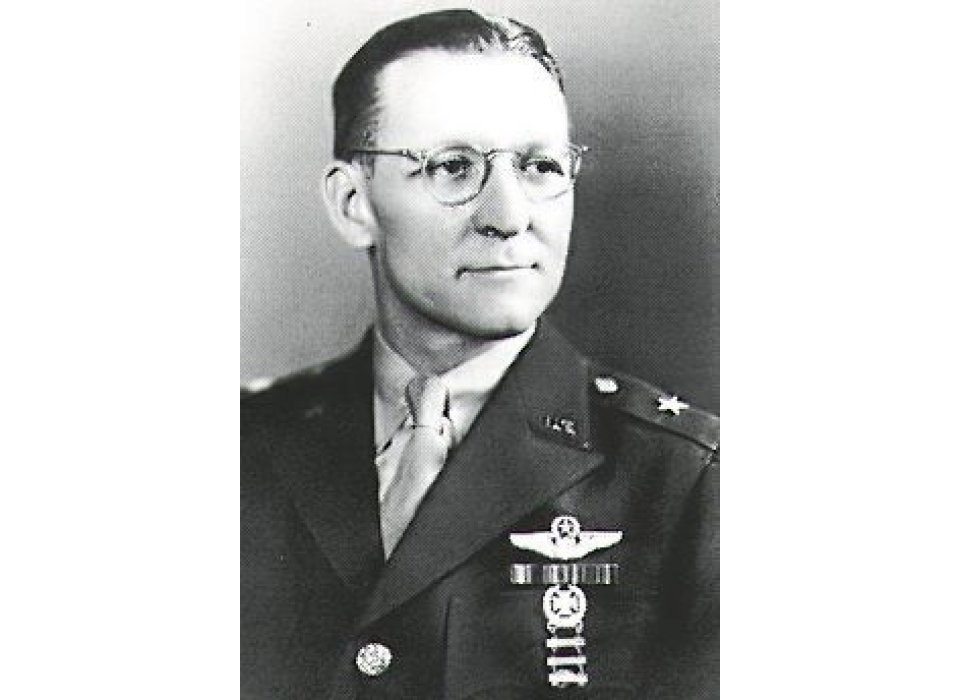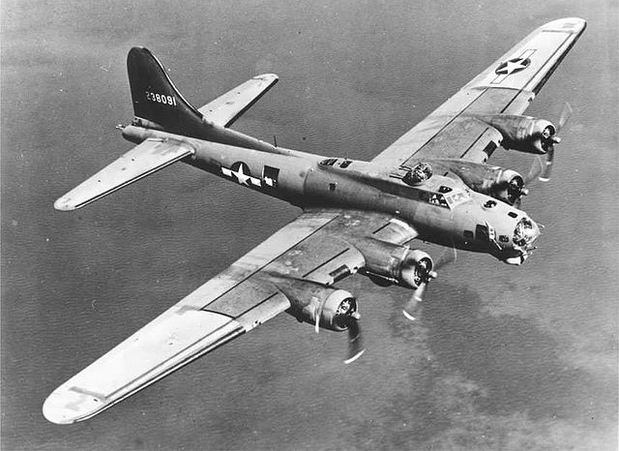Top image: Brigadier General Kenneth N. Walker, Commanding General of the 5th Bomb Command in the Southwest Pacific. Official US Army Photo.
On the morning of January 5, 1943, six Boeing B-17 “Flying Fortresses” and six Consolidated B-24 “Liberator” heavy bombers left Port Moresby Airfield Complex in New Guinea. Their mission: to attack an enemy shipping convoy thought to be headed to the Japanese military base at Rabaul, New Britain. Kenneth Newton Walker, Brigadier General, US Army Air Forces and Commander of 5th Bomber Command was on board the lead B-17, flown by Major Allen Lindberg. After arriving over Rabaul at 12:00 p.m., the bomb group successfully hit nine Japanese ships.
As the formation left the target, however, it was attacked by a squadron of Japanese fighters. According to a Fifth Air Force message, the B-17 on which Walker was aboard was last observed heading south just east of Vunakanau about 10 miles south-southwest of Raubal at approximately 5,000 feet. Its “left outboard engine [was] smoking but later appeared alright” despite being “closely pursued” by four to five enemy fighters. Brig. Gen. Walker and the rest of the crew, however, never returned from the mission, and the 11 airmen were listed as missing in action after several searches proved unsuccessful. Later, the entire crew was reclassified as killed in action.
Kenneth Newton Walker was born on July 17, 1898, in Cerillos, New Mexico, and enlisted in the US Army in December 1917. Walker attended flight training at the University of California’s School of Military Aeronautics and at Mather Field, located near Sacramento, California. Upon receiving his wings in November 1918, he was commissioned as a Second Lieutenant (Temporary) in the US Army Air Service. He then attended the Flying Instructor’s School at Brooks Field in San Antonio, Texas, and served as a flight instructor for three years at Brooks and Barren Fields, Texas, and at Fort Sill, Oklahoma.
In December 1922, as a First Lieutenant, Walker went to the Philippines as Officer in Charge of the Air Intelligence Section at Camp Nichols. After three years, he returned to the United States as a member of the Air Service Board at Langley Field, Virginia. At Langley, he served as Adjutant of the 59th Service Squadron, Commander of the 11th Bomb Squadron, and Operations Officer for the 2nd Bomb Group. In June 1929, he graduated from the Air Corps Tactical School (ACTS) at Maxwell Field, Alabama, and stayed as a bombardment instructor at the school before attending the Command and General Staff School at Fort Leavenworth, Kansas, where he graduated in June 1933. He was promoted to Captain in August 1933 and to Major in October of the same year.
While a bombardment instructor, Walker coined what became known as the “creed of the bomber.” According to airpower historian Michael Robert Patterson, Walker believed that “airpower offered a revolutionary means to pressure an enemy into capitulation without first defeating opposing ground forces.” This concept became a doctrine followed by many Air Force generals for years.
Walker also participated in a study on the accuracy of low-altitude bombing. As Patterson describes, Walker “discovered that, while targeting was more accurate at low altitude, damage was reduced because of ricochets and other factors. Walker learned that delayed-fused bombs and bombs dropped from higher altitude caused more damage.” As a result, Walker and three of his ACTS colleagues created AWDP-Plan 1, which became the bombing blueprint against Germany once the United States entered World War II. As war threatened the United States, Walker was promoted to Lieutenant Colonel and soon to full Colonel.
During World War II, Walker was promoted to Brigadier General and transferred to the Southwest Pacific, where he served as Commanding General of the 5th Bomb Command, Fifth Air Force from September 1942 until his death on January 5, 1943. For his service and actions, Brig. Gen. Walker was awarded the Medal of Honor posthumously by President Roosevelt in 1943.
In addition to the Medal of Honor, Brig. Gen. Kenneth Walker was also previously awarded the Distinguished Service Cross, the Silver Star, the Legion of Merit, and the Purple Heart. In January 1948, Roswell Army Airfield in Roswell, New Mexico, was designated Walker Air Force Base in his honor. Walker Hall at Maxwell Air Force Base, which is home to the College of Aerospace Doctrine, Research, and Education, is also named after General Walker.
Brigadier General Kenneth Walker’s Medal of Honor Citation:
“For conspicuous leadership above and beyond the call of duty involving personal valor and intrepidity at an extreme hazard to life. As commander of the 5th Bomber Command during the period from 5 September 1942 to 5 January 1943, Brig. Gen. Walker repeatedly accompanied his units on bombing missions deep into enemy-held territory. From the lessons personally gained under combat conditions, he developed a highly efficient technique for bombing when opposed by enemy fighter airplanes and by antiaircraft fire. On 5 January 1943, in the face of extremely heavy antiaircraft fire and determined opposition by enemy fighters, he led an effective daylight bombing attack against shipping in the harbor at Rabaul, New Britain, which resulted in direct hits on nine enemy vessels. During this action his airplane was disabled and forced down by the attack of an overwhelming number of enemy fighters.”
Jennifer Popowycz, PhD
Jennifer Popowycz, PhD is the Leventhal Research Fellow at The National WWII Museum. Her research focuses on the Eastern Front and Nazi occupation policies in Eastern Europe in World War II.
Cite this article:
MLA Citation:
APA Citation:
Chicago Style Citation:








![Max Fuchs, New York City cantor, sings as Rabbi Sydney [sic] Lefkowitz, Richmond, VA, conducts the first Jewish services from Germany.](/sites/default/files/styles/max_650x650/public/2025-10/image1.jpg)

